“We are not the promised land” Refugees and the Visegrád states
March 8, 2018
March 8, 2018

February 28, 2018
The Sylff Association is happy to announce the latest addition to the growing list of support programs: “Sylff Leaders Workshop.”
The Workshop will provide an opportunity for selected Sylff fellows to deepen their understanding of differences in peoples’ values, perspectives, and opinions so they may make informed decisions on important social issues and enhance the effectiveness of well-intended actions. The participatory, capacity-building workshop aims to nurture leadership in a multicultural setting.
The workshop will consist of two 8-day programs to be held in fall 2018 and spring 2019 in Japan—primarily outside Tokyo. It will bring together Sylff fellows who have (1) substantial expertise in policy studies or policymaking and/or (2) experience addressing social issues in civil society or the private sector to discuss the “Potential of Trans-border Networking in 2030” through the application of scenario planning methodologies.
Past recipients of Sylff fellowships are invited to apply. Click here to read the call for applications.

February 22, 2018
By 19626
Melinda Kovai, a 2009 Sylff fellow at Eötvös Loránd University in Hungary, and her team members have recently completed their SLI project, which took them over one and a half years, to address the problem of social disparity strongly linked to negative notions toward the “Gypsy.” The project incorporated the idea of reflection on one’s own social position to encourage understanding of different social groups, which contributed to the uniqueness of the project. The training materials, the final project product, have been already integrated into two courses at universities in Hungary. The project members hope that the materials will be utilized in many educational settings not only in Hungary but also in neighboring countries faced with similar social challenges. They are determined to keep working on resolving the issue and extending the impact to society.
***
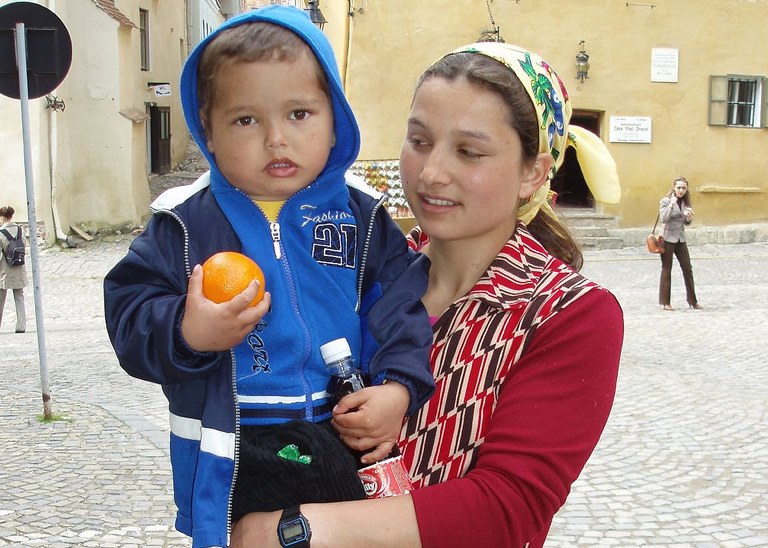
A mother and son of the Roma people, commonly known as Gypsies.
In Hungary, primarily due to their disadvantaged social position, the Roma people are by far the greatest subjects to racism. In public discourse, the “Gypsy” is inseparably bound up with such negative notions as poverty, permanent unemployment, benefits, informal economy, and crime and, more generally, with fears related to existential insecurities. In most social domains, the “Gypsy” is intertwined with a certain inferior class position and social marginality, such as exclusion from or taking the most inferior realms of the formal labor market, with possibilities severely restricted by manifold exclusive processes. The Gypsy-Hungarian ethnic distinction is in many cases a manifestation of class difference, since class positions are heavily ethnicized in many areas of life, in villages and town districts, and in educational and other institutions. While the lower middle and middle classes are associated with majority Hungarians, marginalization from the labor market is associated with the Roma. Everyday social conflicts are hence often experienced as confrontations between different ethnically interpreted class positions, where the “Gypsy” appears as a menace to the middle-class normativity of the majority.
Our team of trainers comprised social scientists whose academic work focuses on social inequalities, public education, and the Roma communities. The project idea arose from a shared urge to engage in activities that have a more direct and palpable impact on the lives of the communities we work with. Therefore, this project was also a way to experiment and to elaborate methods of intervention and ways of committed political engagement that feel right and adequate to us, to our habitus. We held four one-day and four two-day workshops for six groups of university students training to become public-sector professionals and for two groups of Roma university students. Half of the workshops took place in Budapest and the other half in other big cities. In the workshops, participants were invited to work with and reflect on their own social position, their social roles, and their class position. Our workshops are based on the idea that reflection on one’s own social position can help to better understand the behavior of other social groups and encourage collective action and solidarity across groups. Recognizing the social interests and conflicts involved in encounters with the Roma helps to identify the source of negative emotions and reveals how racism veils the real causes of conflicts.
The main target group of our workshops is professionals who regularly encounter Roma clients as part of their professional roles. According to the literature, street-level bureaucrats are public-service professionals who represent the state by their work and, on a daily basis, make numerous small decisions in relation to the lives of their clients.[1] Typical examples of such professions are social workers, health care professionals, and the police. In this project, we offered the trainings to university students preparing to enter these professions; in the future, we plan to approach in-service professionals as well.
The workshops address the complexity and tensions of the professional roles related to social assistance, care, and support. We spend time discussing the typical sociological and recruitment characteristics of the professions. We had to bear in mind that university students do not yet have professional casework experience, so the workshops concentrated on their past “private” minority-majority encounters (which most often happened at school) on the one hand and the motivations, desires, and fears related to the caring relationship on the other.
When working with university students, school was often an important theme: we discussed the role of schooling in social mobility, the class-specific strategies related to schooling, as well as the inequalities of the Hungarian education system, and the school’s role in mitigating or reproducing inequalities.
Our other important target group consisted of young intellectuals of Roma background. In these workshops, we discussed the situation of the Roma people within the Hungarian social structure, the typical Roma roles and social phenomena (e.g., ethnically framed poverty, entrepreneurship, and widening middle class), and the constraints of upward mobility. Subsequently, the workshops addressed the tensions of harmonizing the experience of deprived homes and middle-class intellectual roles. By sharing their stories and experiences, the workshops helped young Roma intellectuals recognize the similarities in their backgrounds and challenges and hence share the “weight” of upward mobility.
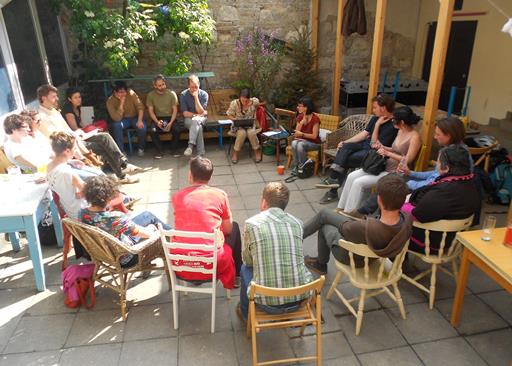
Melinda Kovai, team members, and other sociologists discussing the contents of the training.
The first part of the workshops concentrated on the social positions of the participants; they shared their memories and their private and work experiences in relation to conflicts with the Roma people. We then explored these encounters in a dramatic form, wherein participants placed themselves in the shoes of both sides and collectively explored the social constraints from which behaviors (stereotypically) associated with the “Gypsy” derive. Ideally, the recognition of common social constraints develops a sense of solidarity and recognition of the differences of the other.
It was important to constantly respond to the social differences among participants and the corresponding differences in career choices. On the final day of the workshops for university students, we set aside time to explore their career choices in the light of their social positions and experiences. While for first-generation young intellectuals our workshops shed light on the constraints and possibilities coming with their upward mobility, for young people coming from long-standing intellectual families the training provided an opportunity to reflect on their privileges.
The following training methods were employed in the workshops:
The overall aims were that, by the end of the workshops, participants
At the end of the workshops, as a closure, we asked all participants to share how they enjoyed the course and which elements they liked and disliked in particular. Two weeks after the workshops, we also invited participants to anonymously fill out a detailed online feedback form. In the questionnaire, they could assess group directing, the structure of the workshop, and the tasks and activities, and they were asked to describe their positive and negative experiences and to give us suggestions for improvement. The majority of the participants gave an overall positive feedback on the training and the trainers. They highlighted that, even though it was an emotionally shocking experience, recognizing their own social position and social differences in general were the most important lesson of the workshop. In the participants’ own words:
“I engaged both intellectually and emotionally—I was deeply touched in both respects. I thought a lot about these themes in the time between the workshops. The workshops were emotionally exhausting, but they were also extremely interesting intellectually.”
“I developed a sense of social remorse. . . . I could do so many things to be more responsible socially. . . . I used to see helpers as being in a great distance from me, as being much more clever, experienced, capable people. . . . Yet they just probably took the initiative, started something, and then became good at it. . . . Next year I will volunteer at a shelter for elderly or mentally disabled people.”
“The topics broke taboos. It is painful to realize how stereotypical our thinking is.”
“I grappled with multiple feelings over a short period of time.”
Based on the feedback and our own experiences, we concluded that it would be more worthwhile to organize two- or even three-day workshops for each group. One-day workshops do not provide sufficient time to process such shattering and difficult experiences. One-day workshops were less successful as participants did not have time to open up or, to the contrary, brought in very moving stories and experiences into the group that could not be processed sufficiently and reassuringly in the given time frame. This difficulty was the most striking in the workshops held for Roma colleges. Furthermore, in the cases of both one- and two-day workshops, participants signaled to us that they would welcome more factual knowledge as well as more emphasis on practical solutions for solving conflict situations.
Citing participants:
“The dramatic enactments were great, but I think it would be good to focus on finding some optimal solutions for these situations. This would have helped us in applying what we learned in “real-life situations.”
“You should give us more factual knowledge on the second day. What is integrated education? How was it implemented and responded to? What is the situation with integrated education now? What are the main political claims about the Roma?”
“I was missing some frontal knowledge, as I was interested in data and practices related to [Roma] educational integration in Hungary.”
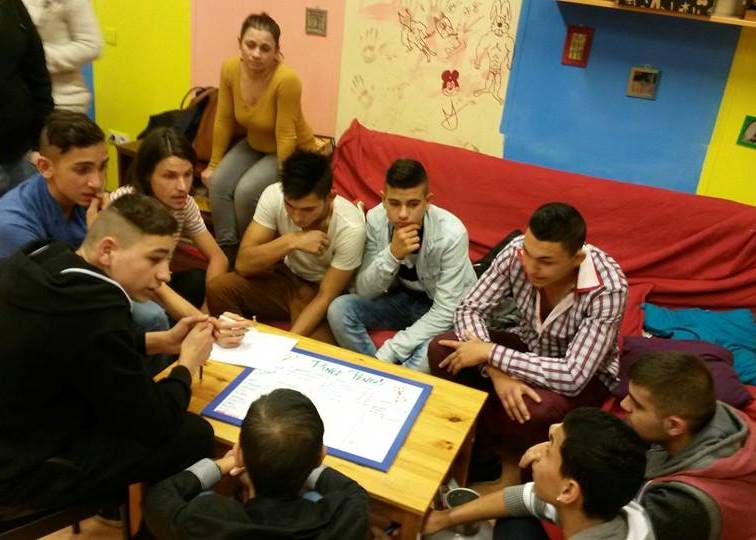
Working with Roma schoolboys.
The final output of the project is a detailed set of training materials based on the workshops. The training materials were produced with two objectives in mind. On the one hand, we would like to provide our partners with an introduction to the workshops in advance. On the other, we are planning to disseminate our methodology among university and secondary school teachers who are using action methods or are trained in social sciences. The document explicates why we think that awareness and reflection on one’s own social position can tackle racist attitudes and in what ways our approach is distinctively different from “traditional” anti-discrimination and intercultural awareness raising trainings. We describe the structure and main elements of the workshops in detail.
It perhaps indicates the success of our project that two of our partners, the Faculty of Social Work at Eötvös Loránd University and the Faculty of Psychology at the Károli Gáspár University of the Reformed Church in Hungary, integrated our training in their curriculum from 2017–2018 under the title of “Meeting with the Other” as an optional course for social worker students at the former and “Socio-analysis for Psychologists” as a mandatory course for psychology students in the latter’s Intercultural Psychology program. The trainings are led by two trainers: Melinda Kovai, who is a university lecturer at both universities, and another member of our team.
According to the participants’ feedback and our own evaluation, the workshops had the most tangible impact among Roma and non-Roma students enrolled in universities outside the capital. These students predominantly come from working-class families or from families in extreme deprivation. The workshops have the potential to help them not to experience their background as a source of shame but, instead, to recognize the resources in their difficult experiences and thus become professionals deeply and proudly committed to their work with socially deprived children and adults. We plan to orient our future workshops to this target group by developing a longer training in close cooperation with our partner institutions. Furthermore, we would like to begin working with professional adults and adapt the training to their needs.
The training materials are available from the following. (Please note they are written all in Hungarian.)
Training material_Hungarian
[1] Lipsky, Michael. Street-Level Bureaucracy: Dilemmas of the Individual in Public Services. New York, NY: Russell Sage Foundation, 1980.


February 13, 2018
February 2, 2018
February 2, 2018
January 11, 2018
January 6, 2018
January 5, 2018

January 5, 2018
By 19685
On September 8 and 9, 2017, five Sylff fellows organized an event aimed at promoting sustainable development in Hungary: Professor Eva Kiss, Dr. Andrea Kunsagi, Dr. Viktoria Ferenc, Dr. Viktor Oliver Lorincz, and Dr. Loretta Huszak. Mari Suzuki, director for leadership development of the Tokyo Foundation, attended the two-day event as a representative of the Sylff Association secretariat to support the fellows’ initiatives. The event was significant in that many participants as well as speakers consisted of past and current Sylff fellows. This opportunity served not only to encourage cooperation between academics and local practitioners in Hungary but also to strengthen the bonds among Sylff fellows in Hungary.
***
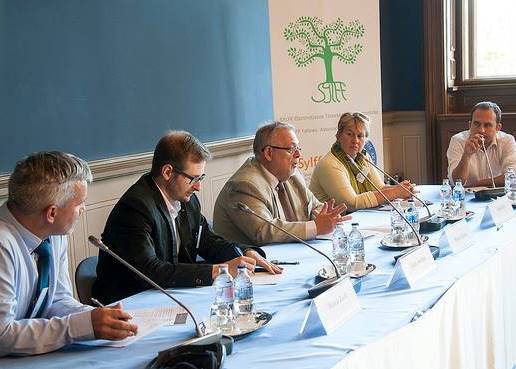
A round-table discussion during the event, titled “Sustainability Initiated ‘Bottom-Up’: Is It Possible?” The participants are (from left to right): Zsolt Molnar, Andras Jakab, Balazs Hamori, Eva Deak, and Andras Takacs-Santa.
Economically and ecologically sustainable development has become a universal concern. It merits the attention and action of all of us. Hungarian fellows of the Ryoichi Sasakawa Young Leaders Fellowship Fund (Sylff) have realized that efforts are needed on a variety of fronts to promote sustainable development. Local and bottom-up initiatives have significant impact and are indispensable for sustainable development. Accordingly, more attention should be paid to them.
Post-communist civil societies, like the one in Hungary, are characterized by a lower level of participation in bottom-up initiatives by ordinary citizens.[1] Nonetheless, recent academic literature indicates that an increasing number of municipalities in Hungary possess local strategies for sustainable development or support initiatives related to sustainability.[2] These initiatives are designed to use and develop the municipalities’ own resources and internal potential to change society for the better.
The focus of the two-day Sylff event was on analyzing how imperative local bottom-up initiatives are to the economic, social, cultural, political, and legal development of modern societies and understanding how their sustainable development can be ensured and observed in Hungary. The first day was dedicated to academic analysis of the above themes, and the second day was a field trip to Szigetmonostor—one of the most active municipalities in Hungary, where the local administration is very much engaged in cooperation with grassroots initiatives. The object of the initiative was to facilitate a bottom-up dialogue between academics and local leaders and initiators. The chief patron of the event was Laszlo Lovasz, president of the Hungarian Academy of Sciences.[3]
The first day of the initiative was an interdisciplinary forum, which took place at the Hungarian Academy of Sciences in Budapest. It was dedicated to the academic analysis of sustainability and to the scientific elaboration of the role of bottom-up local initiatives in sustainable development. After the opening addresses, Andras Takacs-Santa, program director at Eötvös Loránd University Budapest, gave an opening lecture on “The need for a protective science in the light of the ecological crisis.”[4] He pointed out that the imperative of sustainable development is forcing us to think in new ways but that the way to an ecologically sustainable future is not at all yet clear. Human ecology and the sustainable way of thinking about the Earth’s resources should “run out in all directions” and find their path to the Hungarian Academy of Sciences too.
Section 1 of the forum focused on “the spatial dimensions of sustainable development” with five presentations. The well-prepared speakers approached sustainability from different aspects - environmental, economic, and social - and on diverse spatial levels. They dealt with different parts of the world, from the regional to micro level: China, the Carpathian Basin, Visegrad countries, the South-Bekes microregion, and underdeveloped regions of Hungary. Taken as a whole, the presentations significantly contributed to the success of the conference and to a better understanding of the processes of sustainability on different spatial levels. After the presentations, there was a lively discussion in which the audience raised several questions.
Section 2 analyzed “the successes and anomalies in communication and their role in community generating, business, and social life.” These aspects were investigated from psychological, marketing, management, and human-ecological collateral perspectives. The impact of people on their environment also prevails by numerous forms of manifestation in communication. Making public property from successes and anomalies in communication may help initiate more constructive societal, business, and grassroots movements and give these movements sustainability.
“The human dimension of biodiversity” was studied in section 3. Biodiversity can be found in both nature and culture. Our world is a living network made up of the millions of species of plants and animals and thousands of human cultures and languages that have developed over time. Languages, cultures, and ecosystems are interdependent. For humanity at large, the loss of cultural and linguistic diversity represents a drastic reduction of our collective human heritage. In this section, Sylff fellows discussed human communities that have special attributes in ethnic, linguistic, and cultural respects and whose existence is endangered. The topic is highly relevant in Europe as well as in the Hungarian context. The objective of the panel was to shed light on the importance of maintaining these communities and to link the knowledge represented by Sylff fellows to the practice of local actors and decision makers in Hungary.
Topping the presentation part of the forum was the legal section, which focused on “law and equity in a sustainable society.” Beyond environmental law, the question of sustainability also emerges in other domains of legal studies and political sciences, such as constitutional law, the institutional background of the protection of future generations, populism versus long-term policymaking, and the economic aspects of environmental damages and its legal consequences.
The conference day closed with a round-table discussion. Invited participants talked about the question of “sustainability initiated ‘bottom-up’: is it possible?” It was a valuable discussion, not only in that it summarized the main findings of the conference day but also because it brought together academia and municipalities with bottom-up local initiatives, as well as nongovernmental organizations, and raised expectations for the field trip that was to follow the next day.
A key point of the conference day was that the presentations went beyond the speakers’ own research, adding aspects of sustainable economic development. They encouraged the audience to analyze the theme from broad perspectives and led to a successful forum, as audience members were able to understand the contents without specialized knowledge. The perspectives that were offered helped not only to identify research interests shared by the different disciplines but also to link academic knowledge with local practice.

Discussion during the workshop in Szigetmonostor.
The field trip to Szigetmonostor was aimed at disseminating and applying academic knowledge to the field. To achieve these goals, academics—scientists employed by HAS (research institutions) and people employed by institutions of higher education—went to the field and experienced knowledge spillovers to the locals. Another aim was to heighten the awareness of local initiators about how academics can support and help their initiatives, thereby helping theoretical academic projects take on a more applied and realistic role; in other words, to help academic projects realize themselves in a more practical pragmatic environment.
The main reason for choosing Szigetmonostor was its isolation. Although the village is just 25 km from Budapest, it is difficult to access due to poor infrastructure; because there is no direct motorway, the only ways of reaching it are via a 50-km detour or by ferry.[5] This makes the village unique in its inhabitants’ reliance on one another. Given the natural beauty and environment of the place, which has been underdeveloped to date, it is an ideal spot to develop tourism. There is a need to create job opportunities within Szigetmonostor, as its geographic location makes it difficult for the locals to seek job opportunities in central Budapest.
Activities provided by Sylff fellows included raising awareness of the historical background of Szigetmonostor among the academic participants. Mayor Zsolt Molnar of Szigetmonostor elaborated on the current situation that the half-island was facing.[6] He gave his account at the dam, with the Danube and the city of Budapest visible in the background. This setting enhanced and inspired the visitors’ interest.
After this opening, the focus turned to local initiatives. Local initiators presented their activities and highlighted the key social challenges that they wanted to be tackled. A short group session followed, in which participants were divided into groups and had to identify possible solutions to local issues. These discussions were led by professional mediators as well as local experts. The idea was to find a common ground between the academics and locals to help with Szigetmonostor’s advancement in terms of tourism, education, local job creation, and so forth.
The group work was then followed by participants presenting new ideas and possible solutions to existing difficulties. The group activities provided a great platform for initiating future collaboration between the academics and local initiators.
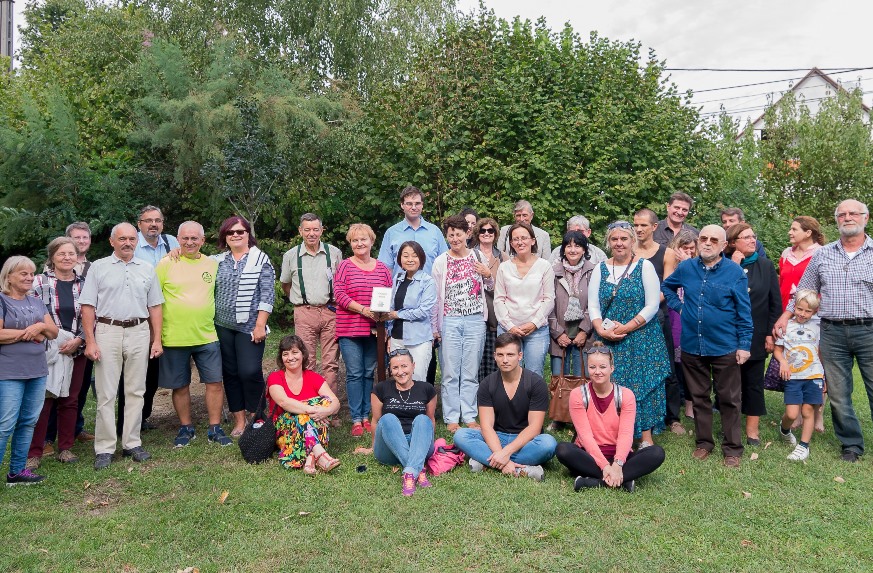
Hungarian Sylff fellows and locals in Szigetmonstor, with the newly planted Sylff tree in the background. Holding the plaque for the tree at center are Mariann Tarnoczy, who has been working with Sylff at the Hungarian Academy of Sciences since the program’s inception, and Mari Suzuki, director of leadership development at the Tokyo Foundation.
To mark Sylff’s contribution and its recognition for future collaboration, the group of workshop participants went out to a beautiful park built by the local volunteers, where they planted a South European flowering ash tree as a symbol for future collaboration. With the help of locals, the academics dug the ground and planted and watered the new tree.
The two-day event was well attended, which is an objective indicator of success. Eighty-one people attended the conference day, almost half of whom were Hungarian Sylff fellows. The workshop day in Szigetmonostor saw the participation of 45 academics and locals; the number of Sylff fellows was 12.
The initiative aspired to link academic knowledge and local practice. Analyzing sustainable local initiatives and their impact on society was a new activity field for most of the participants. The researchers who gave presentations had been invited to combine their actual research with this important topic. It was an experiment that made great demands of the presenters but led to unforeseen ties between researchers from different disciplines—to real-time interdisciplinary interactions.
The initiative also had the aim of contributing to society. Understanding basic human ecology principles and the operation of local initiatives can help to map out and evaluate alternatives. The participants identified such principles and recognized new opportunities for cooperation between local initiators and academics. We hope that this future cooperation will lead to positive social change in such forms as increased citizens’ participation in local initiatives, better understanding of the significance of such initiatives among scholars, and more academic projects taking on advanced applied and realistic roles.
A well-informed public is crucial for sustainable development. The media can help reach a wider audience, inform local stakeholders, and direct attention to the role of local initiatives in Hungary’s sustainable economic development. The first report of the initiative has already been published; an article appeared in the local online newspaper of Szigetmonostor, informing local stakeholders about the event..[7]
The organizers of the initiative have prepared a special edition for Magyar Tudomany, the periodical of the Hungarian Academy of Sciences. All manuscripts are completed and should be published in the coming weeks. In addition, a seven-minute video on the initiative will be published soon on social media and Internet channels (YouTube and Facebook).

The main organizers of the event (from left to right): Viktoria Ferenc, Andrea Kunsagi, Eva Kiss, Loretta Huszak, and Viktor Lorincz.
[1] Marc Marje Howard, The Weakness of Civil Society in Post-Communist Europe (Cambridge: Cambridge University Press, 2013), p. i.
[2] Henrietta Nagy, Tamas Toth, and Izabella Olah, “The Role of Local Markets in the Sustainable Economic Development of Hungarian Rural Areas,” Visegrad Journal on Bioeconomy and Sustainable Development, vol. 1, no. 1 (2012): pp. 27–31. https://vua.uniag.sk/sites/default/files/27-31.pdf
[3] For a list of elected chief officers of the Hungarian Academy of Sciences see:
http://mta.hu/english/elected-chief-officers-of-mta-106110
[4] For further information on Andras Takacs-Santa visit: http://tatk.elte.hu/en/staff/TakacsSantaAndras
[5] Official website of the municipality: http://szigetmonostor.hu/ (in Hungarian)
[6] For further information on Zsolt Molnar visit: http://szigetmonostor.hu/index.php/onkormanyzat/polgarmester (in Hungarian)
[7] Loretta Huszak, “Az MTA kutatóinak és ösztöndíjasainak látogatása Szigetmonostoron,” Ujsagolo, vol. 23, no. 10 (October 2017): pp. 1, 10. http://szigetmonostor.hu/images/dokumentumok/ujsagolo/ujsagolo_2017_10.pdf

